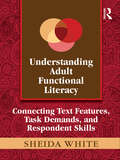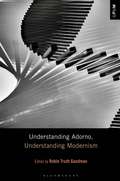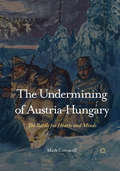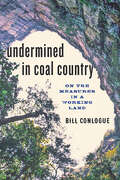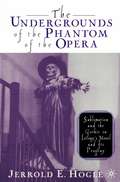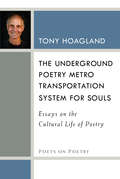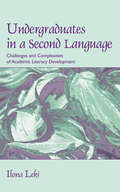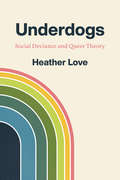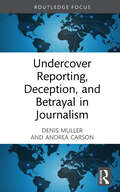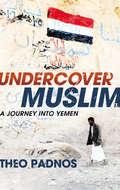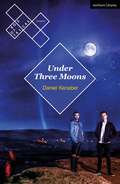- Table View
- List View
Understanding Adult Functional Literacy: Connecting Text Features, Task Demands, and Respondent Skills
by Sheida White"This is a genuinely scholarly work ... It is based on [analysis of] the most up-to-date quantitative surveys that we have on adult literacy. These surveys are the gold standard in terms of documenting adult literacy in the United States ...The author analyzes these extensive surveys and puts them into a theoretical context in a way that has not been done before." – Rosemary J. Park, University of Minnesota "I don’t know of any book providing the same information. There is a shortage of literature in this area and the book is an excellent contribution." – Dolores Perin, Teachers College, Columbia University "The contribution of the theory is important – not only to adult literacy but to our understanding of the reading process at nearly every level ... Additionally, the application of multidimensional item response modeling to the new TTR theory offers a tantalizing view of how the predictive validity of a theory might be tested and used to provide practical results." – Larry Mikulecky, Indiana University Very often, individual differences in literacy performance are understood exclusively in terms of the characteristics of the reader. Drawing on a rich array of empirical research, the author presents a detailed and highly integrative new theory of functional literacy. The text-task-respondent (TTR) theory of functional literacy offers improved understanding of how successful performance on everyday literacy tasks involves a dynamic relationship among the text, the task, and the reader. This book will appeal primarily to assessment developers who wish to select tasks and texts of varying difficulty to yield more precise estimates of adult literacy; to researchers who study cognitive, linguistic, and discourse processes; and to teachers who want to find new ways to increase text comprehension among students, including English language learners and struggling readers. The text is appropriate for an advanced course in adult education, discourse analysis, educational measurement, educational psychology, literacy, or linguistics – or as a reference work for those interested in literacy.
Understanding Adorno, Understanding Modernism (Understanding Philosophy, Understanding Modernism)
by Robin Truth GoodmanHaving studied philosophy at a time when its traditions were being seriously uprooted by the atrocities of World War II, Theodor Adorno had an enormous impact on thinking about aesthetics at a transitional historical moment when the philosophy of science and leftist politics were looking for new ground. Moreover, with his focus on the rise of commercial culture and its effects on identity-construction, Adorno can be said to have reinvigorated modernist concerns by introducing the prevailing terms in our contemporary versions of cultural politics and cultural studies. Understanding Adorno, Understanding Modernism traces Adorno's social and aesthetic ideas as they appear and reappear in his corpus. As per other volumes in the series, this book is divided into three parts. The first, “Adorno's Keywords,” is organized by the aesthetic terms around which Adorno's philosophy circulates. The second section is devoted to “Adorno and Aesthetics.” While Adorno's philosophical viewpoints influenced modernism's evolution into the 21st century, the history of modernist aesthetics also shaped his philosophical approaches. The third and final part, “Adorno's Constellations,” discusses how aesthetic form in Adorno's thinking underlies the terms of his social analysis.
Understanding Adorno, Understanding Modernism (Understanding Philosophy, Understanding Modernism)
Having studied philosophy at a time when its traditions were being seriously uprooted by the atrocities of World War II, Theodor Adorno had an enormous impact on thinking about aesthetics at a transitional historical moment when the philosophy of science and leftist politics were looking for new ground. Moreover, with his focus on the rise of commercial culture and its effects on identity-construction, Adorno can be said to have reinvigorated modernist concerns by introducing the prevailing terms in our contemporary versions of cultural politics and cultural studies. Understanding Adorno, Understanding Modernism traces Adorno's social and aesthetic ideas as they appear and reappear in his corpus. As per other volumes in the series, this book is divided into three parts. The first, “Adorno's Keywords,” is organized by the aesthetic terms around which Adorno's philosophy circulates. The second section is devoted to “Adorno and Aesthetics.” While Adorno's philosophical viewpoints influenced modernism's evolution into the 21st century, the history of modernist aesthetics also shaped his philosophical approaches. The third and final part, “Adorno's Constellations,” discusses how aesthetic form in Adorno's thinking underlies the terms of his social analysis.
Understanding Abstract Concepts across Modes in Multimodal Discourse: A Cognitive Linguistic Approach (Routledge Focus on Linguistics)
by Elżbieta GórskaThis volume looks at spatialization of abstract concepts in verbo-pictorial aphorisms at work in the cartoons of a single artist. While extensive work has been done in studying spatialization of abstract concepts in grammar and lexicon within cognitive linguistics, this book is the first of its kind to provide a detailed account of such phenomena in multimodal discourse. The volume integrates a range of approaches from cognitive linguistics, including image schema theory, conceptual theory of metaphor, multimodal metaphor theory, the dynamic approach to metaphor, and a multimodal approach to metonymy, and applies this multi-faceted framework to a selection of cartoons from the work of Polish artist Janusz Kapusta. Taken together, these cartoons form the basis of two comprehensive case studies which explore the abstract concepts of "emotions" and "life," highlighting the ways in which cartoons can illustrate the important relationship between space, situated cognition, and language and in turn, a clear and systematic framework for establishing cohesive ties between the verbal and pictorial modes in multimodal cognitive linguistic research. The volume sheds new light on visual thinking and multimodal rendition of creative abstract thought.
Understanding Abstract Concepts across Modes in Multimodal Discourse: A Cognitive Linguistic Approach (Routledge Focus on Linguistics)
by Elżbieta GórskaThis volume looks at spatialization of abstract concepts in verbo-pictorial aphorisms at work in the cartoons of a single artist. While extensive work has been done in studying spatialization of abstract concepts in grammar and lexicon within cognitive linguistics, this book is the first of its kind to provide a detailed account of such phenomena in multimodal discourse. The volume integrates a range of approaches from cognitive linguistics, including image schema theory, conceptual theory of metaphor, multimodal metaphor theory, the dynamic approach to metaphor, and a multimodal approach to metonymy, and applies this multi-faceted framework to a selection of cartoons from the work of Polish artist Janusz Kapusta. Taken together, these cartoons form the basis of two comprehensive case studies which explore the abstract concepts of "emotions" and "life," highlighting the ways in which cartoons can illustrate the important relationship between space, situated cognition, and language and in turn, a clear and systematic framework for establishing cohesive ties between the verbal and pictorial modes in multimodal cognitive linguistic research. The volume sheds new light on visual thinking and multimodal rendition of creative abstract thought.
Understand the publishing process, and finish writing your book in 12 weeks (Author Training Series #1)
by David NorringtonAccompanies the workshop. Covers the stages you'll need to consider before you start. This for you if you: >have been trying to finish your book but have blockages >want to write a book but don't know where to start >have an idea but are overwhelmed by what to include >want to understand the publishing process.
The Undermining of Austria-Hungary: The Battle for Hearts and Minds
by M. CornwallThis is a major new contribution to the historiography of the First World War. It examines the lively battle of ideas which helped to destroy Austria-Hungary. It also assesses, for the first time, the weapon of 'front propaganda' as used by and against the Empire on the Italian and Eastern Fronts. Based on material in eight languages, the work challenges accepted views about Britain's primacy in the field of propaganda, while casting fresh light on the creation of Yugoslavia and the viability of the Habsburg Empire in its last years.
Undermined in Coal Country: On the Measures in a Working Land
by Bill ConlogueDeep mining ended decades ago in Pennsylvania;€™s Lackawanna Valley. The barons who made their fortunes have moved on. Low wages and high unemployment haunt the area, and the people left behind wonder whether to stay or seek their fortunes elsewhere.Bill Conlogue explores how two overlapping coal country landscapes;¢;‚¬;€?Scranton, Pennsylvania, and Marywood University;¢;‚¬;€?have coped with the devastating aftermath of mining. Examining the far-reaching environmental effects of mining, this beautifully written book asks bigger questions about what it means to influence a landscape to this extent;¢;‚¬;€?and then to live in it. In prose rivaling that of Annie Dillard and John McPhee, Conlogue argues that, if we are serious about solving environmental problems, if we are serious about knowing where we are and what happens there, we need to attend closely to all places;¢;‚¬;€?that is, to attend to the world in a cold, dark, and disorienting universe. Unearthing new ways of thinking about place, pedagogy, and the environment, this meditative text reveals that place is inherently unstable.
The Undergrounds of the Phantom of the Opera: Sublimation and the Gothic in Leroux's Novel and its Progeny
by J. HogleThis is the most comprehensive analytical study ever done of The Phantom of the Opera in its many different versions from the original Gaston Leroux novel to the present day. It proposes answers to the question, 'why do we keep needing this story told and retold in the Western world?' by revealing the history of deep cultural tensions that underlie the novel and each major adaptation. Using extensive historical and textual evidence and drawing on perspectives from several theories of cultural study, this book argues that we need this tale told and reconfigured because it provides us ways to both confront and disguise how we have fashioned our senses of identity in the Western middle class. The Phantom of the Opera - in varying ways over time - turns out like the 'Gothic' tradition it extends, to be deeply connected to Western self-fashioning in the face of conflicted attitudes about class, gender, race, religious beliefs, Freudian psychology, economic and international tensions, and especially the shifting and permeable boundaries between 'high' and 'low' culture. This book should interest all students of the history of Western culture, as well as those especially fascinated by Gothic fiction, opera, musical theatre, and film.
Underground Writing: The London Tube from George Gissing to Virginia Woolf
by David WelshThe purpose of this book is to explore the ways in which the London Underground/ Tube was ‘mapped’ by a number of writers from George Gissing to Virginia Woolf. From late Victorian London to the end of the World War II, ‘underground writing’ created an imaginative world beneath the streets of London. The real subterranean railway was therefore re-enacted in number of ways in writing, including as Dantean Underworld or hell, as gateway to a utopian future, as psychological looking- glass or as place of safety and security. The book is a chronological study from the opening of the first underground in the 1860s to its role in WW2. Each chapter explores perspectives on the underground in a number of writers, starting with George Gissing in the 1880s, moving through the work of H. G. Wells and into the writing of the 1920s & 1930s including Virginia Woolf and George Orwell. It concludes with its portrayal in the fiction, poetry and art (including Henry Moore) of WW2. The approach takes a broadly cultural studies perspective, crossing the boundaries of transport history, literature and London/ urban studies. It draws mainly on fiction but also uses poetry, art, journals, postcards and posters to illustrate. It links the actual underground trains, tracks and stations to the metaphorical world of ‘underground writing’ and places the writing in a social/ political context.
The Underground Poetry Metro Transportation System for Souls: Essays on the Cultural Life of Poetry (Poets On Poetry)
by Tony HoaglandThe Underground Poetry Metro Transportation System for Souls collects 16 essays by late Tony Hoagland. Gathered by Hoagland himself into a volume for the Poets on Poetry series, these pieces grapple with an expansive range of poetic and cultural concerns—and the surprising and necessary knowledge to be found where they cross paths. His trademark humor and irony, at once approachable, thoughtful, and sophisticated, lead the way toward clear-eyed, sometimes difficult, considerations of contemporary American culture. Through his curiosity, he elevates the seemingly quotidian into a profound subject worthy of close consideration. Hoagland’s generosity of spirit imbues his work with empathy for experiences beyond his own, and his honesty allows him to turn a critical eye on himself and to acknowledge the limits of his understanding. This collection will be rewarding not just for readers of contemporary poetry, but for anyone who wants to step back, take a look at our American reality, and know we’ll be okay.
Undergraduates in a Second Language: Challenges and Complexities of Academic Literacy Development
by Ilona LekiThis is the first book-length study of bilingual, international, and immigrant students in English writing courses that attempts to fully embed their writing experiences within the broader frame of their personal histories, the human context of their development, and the disciplinary contexts of their majors. It addresses the questions: How useful are L2 writing courses for the students who are required to take them? What do the students carry with them from these courses to their other disciplinary courses across the curriculum? What happens to these students after they leave ESL, English, or writing classes? Drawing on data from a 5-year longitudinal study of four university students for whom English was not their strongest/primary language, it captures their literacy experiences throughout their undergraduate careers. The intensive case studies answer some questions and raise others about these students’ academic development as it entwined with their social experiences and identity formation and with the ideological context of studying at a US university in the 1990s.
Undergraduates in a Second Language: Challenges and Complexities of Academic Literacy Development
by Ilona LekiThis is the first book-length study of bilingual, international, and immigrant students in English writing courses that attempts to fully embed their writing experiences within the broader frame of their personal histories, the human context of their development, and the disciplinary contexts of their majors. It addresses the questions: How useful are L2 writing courses for the students who are required to take them? What do the students carry with them from these courses to their other disciplinary courses across the curriculum? What happens to these students after they leave ESL, English, or writing classes? Drawing on data from a 5-year longitudinal study of four university students for whom English was not their strongest/primary language, it captures their literacy experiences throughout their undergraduate careers. The intensive case studies answer some questions and raise others about these students’ academic development as it entwined with their social experiences and identity formation and with the ideological context of studying at a US university in the 1990s.
The Undergraduate's Companion to Arab Writers and Their Web Sites (Author Research Series)
by Dona S. StraleyThis companion provides information on the lives and works of about 150 authors who write primarily in Arabic, covering the first known works of Arabic literature in the 5th and 6th centuries A.D. to the present day. While concentrating on literary authors, writers from the fields of history, geography, and philosophy are also represented. The individuals represented were chosen primarily from the Encyclopedia of Arabic Literature. Among the major authors are Najib Mahfuz, the 1988 Nobel laureate; Nawal Saadawi, the Egyptian physician who is the leading female literary author in the Arab world and the most frequently translated into English; Abu al-Ala' al-Ma'arri, the 11th century poet whose verses are taught to every Arab schoolchild; and Avicenna, the great physician and philosopher, transmitter and interpreter of Aristotle, whose work on medicine was long the standard not only in the Middle East but also (in Latin translation) in Europe. In addition, entries will be included for the anonymous romances so common in Arabic literature, such as The Arabian Nights, a cycle of stories perhaps even better known in the West than in the Arab world.Interest in the history and culture of the Arab world at U.S. universities has taken a quantum leap since the events of September 11, 2001. In this book, the author demonstrates that at least three major, distinct literary and cultural traditions are included within the fields of Middle Eastern and Islamic studies—Arabic, Persian, and Turkic. The Arabic tradition is the oldest, largest, and most widely dispersed. Undergraduate courses in Arabic literature and culture are now being taught at both lower- and upper-levels at many universities. Such courses are often used by undergraduates to fulfill basic educational requirements for their degrees. Students in such courses often have difficulty finding information on Arab writers, and this volume fills the void.
Underdogs: Social Deviance and Queer Theory
by Heather LoveA pathbreaking genealogy of queer theory that traces its roots to an unexpected source: sociological research on marginal communities in the era before Stonewall. The sociology of “social deviants” flourished in the United States at midcentury, studying the lives of outsiders such as homosexuals, Jews, disabled people, drug addicts, and political radicals. But in the following decades, many of these downcast figures would become the architects of new social movements, activists in revolt against institutions, the state, and social constraint. As queer theory gained prominence as a subfield of the humanities in the late 1980s, it seemed to inherit these radical, activist impulses—challenging not only gender and sexual norms, but also the nature of society itself. With Underdogs, Heather Love shows that queer theorists inherited as much from sociologists as they did from activists. Through theoretical and archival work, Love traces the connection between midcentury studies of deviance and the antinormative, antiessentialist field of queer theory. While sociologists saw deviance as an inevitable fact of social life, queer theorists embraced it as a rallying cry. A robust interdisciplinary history of the field, Underdogs stages a reencounter with the practices and communities that underwrite radical queer thought.
Underdogs: Social Deviance and Queer Theory
by Heather LoveA pathbreaking genealogy of queer theory that traces its roots to an unexpected source: sociological research on marginal communities in the era before Stonewall. The sociology of “social deviants” flourished in the United States at midcentury, studying the lives of outsiders such as homosexuals, Jews, disabled people, drug addicts, and political radicals. But in the following decades, many of these downcast figures would become the architects of new social movements, activists in revolt against institutions, the state, and social constraint. As queer theory gained prominence as a subfield of the humanities in the late 1980s, it seemed to inherit these radical, activist impulses—challenging not only gender and sexual norms, but also the nature of society itself. With Underdogs, Heather Love shows that queer theorists inherited as much from sociologists as they did from activists. Through theoretical and archival work, Love traces the connection between midcentury studies of deviance and the antinormative, antiessentialist field of queer theory. While sociologists saw deviance as an inevitable fact of social life, queer theorists embraced it as a rallying cry. A robust interdisciplinary history of the field, Underdogs stages a reencounter with the practices and communities that underwrite radical queer thought.
Undercover Reporting, Deception, and Betrayal in Journalism (Routledge Focus on Journalism Studies)
by Denis Muller Andrea CarsonThis book discusses undercover reporting and deception in journalism, addressing the ethical issues encountered by professionals when deception is involved and providing an explanation of how high-profile cases have developed. Carson and Muller begin by examining how philosophical theories which form the basis of contemporary ethical codes for journalists, bear upon undercover reporting and questions of deception in the digital age. Drawing upon case studies such as Al Jazeera’s undercover operation against the National Rifle Association in the US and the One Nation political party in Australia, and Britain’s Channel 4 infiltration of Cambridge Analytica, this book goes on to define and discuss the ethical concepts behind deception and betrayal and lays out an original ethical framework for undercover journalists facing related challenges in their work. Undercover Reporting, Deception and Betrayal in Journalism is an important research text for students and academics in journalism and media studies.
Undercover Reporting, Deception, and Betrayal in Journalism (Routledge Focus on Journalism Studies)
by Denis Muller Andrea CarsonThis book discusses undercover reporting and deception in journalism, addressing the ethical issues encountered by professionals when deception is involved and providing an explanation of how high-profile cases have developed. Carson and Muller begin by examining how philosophical theories which form the basis of contemporary ethical codes for journalists, bear upon undercover reporting and questions of deception in the digital age. Drawing upon case studies such as Al Jazeera’s undercover operation against the National Rifle Association in the US and the One Nation political party in Australia, and Britain’s Channel 4 infiltration of Cambridge Analytica, this book goes on to define and discuss the ethical concepts behind deception and betrayal and lays out an original ethical framework for undercover journalists facing related challenges in their work. Undercover Reporting, Deception and Betrayal in Journalism is an important research text for students and academics in journalism and media studies.
Undercover Muslim: A Journey into Yemen
by Theo PadnosIn December 2009 the US government launched an air strike against the tiny Yemeni village of al-Majalah where al-Qaeda militants were believed to be in hiding. A second attack a week later targeted the prominent religious leader Anwar Awlaki. He escaped unharmed but many villagers were killed. These two strikes were intended to set back al-Qaeda's operations in Yemen but, within 24 hours, Umar Farouk Abdulmutallab - a 23-year-old Nigerian man and one of Awlaki's followers - boarded a plane to Detroit with explosives hidden in his clothing. His is not a unique story: at a time when true pluralism remains an aspiration rather than a reality in the West, young men, disillusioned and angry with the spiritually barren, consumerist societies in which they live, travel to Yemen in search of fulfilment. There, in the country's anarchic wilderness, they find what they could not at home: a pure way of life, submissive wives and like-minded brethren. Some, like Abdulmutallab, find something much more dangerous: the conviction to carry out Jihad.In Undercover Muslim, Theo Padnos brilliantly evokes a landscape and journey that few Westerners have experienced. He investigates the radicalisation of these disaffected young men as they move, almost unnoticed, from London, Berlin or Paris to their new spiritual home in Yemen.Padnos's journey takes him from the newsroom of a Yemeni newspaper to the prayer rows and lecture rooms of Yemen's madrassas, from covert Jeep rides into the sacred mountains to a stint in an overcrowded prison. It is through these events, and through the people he encounters, that Padnos shows us how a terrifying gulf has opened between Islam and the West.
Under Three Moons (Modern Plays)
by Daniel KanaberSpanning half a lifetime, Under Three Moons takes place on three nights across three decades of two friends' lives. From a school trip to France as teenagers, to a surf shack in their twenties, to Christmas in their thirties, Mike and Paul meet up and talk into the night. From boyhood to manhood to fatherhood, these are the nights they share.This sharp two-hander concerns society's shifting view of male identity, how we've gone from talk of 'lad culture' to the 'metro-sexual' and now 'toxic masculinity'. Male mental health has become much more understood if not discussed enough and the way men relate to their friends and to themselves, is complicated and emotionally obtuse. Under Three Moons is about a male friendship, two men growing together, a relationship that's close but often un-articulated, and how that lack of direct expression can become the defining trait in a life.
Under Three Moons (Modern Plays)
by Daniel KanaberSpanning half a lifetime, Under Three Moons takes place on three nights across three decades of two friends' lives. From a school trip to France as teenagers, to a surf shack in their twenties, to Christmas in their thirties, Mike and Paul meet up and talk into the night. From boyhood to manhood to fatherhood, these are the nights they share.This sharp two-hander concerns society's shifting view of male identity, how we've gone from talk of 'lad culture' to the 'metro-sexual' and now 'toxic masculinity'. Male mental health has become much more understood if not discussed enough and the way men relate to their friends and to themselves, is complicated and emotionally obtuse. Under Three Moons is about a male friendship, two men growing together, a relationship that's close but often un-articulated, and how that lack of direct expression can become the defining trait in a life.
Under the Red White and Blue: Patriotism, Disenchantment and the Stubborn Myth of the Great Gatsby
by Greil MarcusA deep dive into how F. Scott Fitzgerald’s vision of the American Dream has been understood, portrayed, distorted, misused, and kept alive Renowned critic Greil Marcus takes on the fascinating legacy of F. Scott Fitzgerald’s The Great Gatsby. An enthralling parable (or a cheap metaphor) of the American Dream as a beckoning finger toward a con game, a kind of virus infecting artists of all sorts over nearly a century, Fitzgerald’s story has become a key to American culture and American life itself. Marcus follows the arc of The Great Gatsby from 1925 into the ways it has insinuated itself into works by writers such as Philip Roth and Raymond Chandler; found echoes in the work of performers from Jelly Roll Morton to Lana Del Rey; and continued to rewrite both its own story and that of the country at large in the hands of dramatists and filmmakers from the 1920s to John Collins’s 2006 Gatz and Baz Luhrmann’s critically reviled (here celebrated) 2013 movie version—the fourth, so far.
Under the Cover: The Creation, Production, and Reception of a Novel
by Clayton ChildressUnder the Cover follows the life trajectory of a single work of fiction from its initial inspiration to its reception by reviewers and readers. The subject is Jarrettsville, a historical novel by Cornelia Nixon, which was published in 2009 and based on an actual murder committed by an ancestor of Nixon's in the postbellum South.Clayton Childress takes you behind the scenes to examine how Jarrettsville was shepherded across three interdependent fields—authoring, publishing, and reading—and how it was transformed by its journey. Along the way, he covers all aspects of the life of a book, including the author's creative process, the role of the literary agent, how editors decide which books to acquire, how publishers build lists and distinguish themselves from other publishers, how they sell a book to stores and publicize it, and how authors choose their next projects. Childress looks at how books get selected for the front tables in bookstores, why reviewers and readers can draw such different meanings from the same novel, and how book groups across the country make sense of a novel and what it means to them.Drawing on original survey data, in-depth interviews, and groundbreaking ethnographic fieldwork, Under the Cover reveals how decisions are made, inequalities are reproduced, and novels are built to travel in the creation, production, and consumption of culture.
Under the Cover: The Creation, Production, and Reception of a Novel
by Clayton ChildressUnder the Cover follows the life trajectory of a single work of fiction from its initial inspiration to its reception by reviewers and readers. The subject is Jarrettsville, a historical novel by Cornelia Nixon, which was published in 2009 and based on an actual murder committed by an ancestor of Nixon's in the postbellum South.Clayton Childress takes you behind the scenes to examine how Jarrettsville was shepherded across three interdependent fields—authoring, publishing, and reading—and how it was transformed by its journey. Along the way, he covers all aspects of the life of a book, including the author's creative process, the role of the literary agent, how editors decide which books to acquire, how publishers build lists and distinguish themselves from other publishers, how they sell a book to stores and publicize it, and how authors choose their next projects. Childress looks at how books get selected for the front tables in bookstores, why reviewers and readers can draw such different meanings from the same novel, and how book groups across the country make sense of a novel and what it means to them.Drawing on original survey data, in-depth interviews, and groundbreaking ethnographic fieldwork, Under the Cover reveals how decisions are made, inequalities are reproduced, and novels are built to travel in the creation, production, and consumption of culture.
Under the Bhasha Gaze: Modernity and Indian Literature
by Prof PP RaveendranThe book is a study of literature in India in the context of recent discussions on modernity and its theoretical extensions such as the everyday and the social imaginary. It is a critique of the aesthetics and politics of modernity as they are embodied in Indian bhasha literature of the past two centuries. The primary objective of the book is to explore the trajectory of modernity after Indian literature encountered colonialism in the early 19th century. The intricate ways in which the bhasha imagination negotiated questions around concepts such as colonialism, aesthetics, the literary, the historical, and the social, have received focused attention in the analysis. Although the study acknowledges the European provenance of modernity as a historical idea, it also recognizes the inherent complexity of the concept and its equivocal connotations when used with reference to the polyphonic bhasha communities in India. Theoretical issues debated in relation to modernity such as its conceptual affinities with the western enlightenment project, its ideological investment in European aesthetics, and its implication for the evolution of what might be called the hermetic aesthetic are significant to this study. The work also examines the regional strengths of the social imaginary that render a conventionally conceived modernity inadequate in explaining the uniquely modern strengths of the Indian bhasha imagination.
